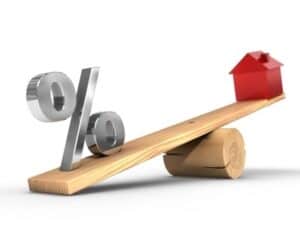 When you contact a bank or lender for an interest rate quote you’ll discover that while the rates are similar, they can and will change over time. Have you ever wondered why? Why don’t lenders just issue an interest rate and let it go for a while?
When you contact a bank or lender for an interest rate quote you’ll discover that while the rates are similar, they can and will change over time. Have you ever wondered why? Why don’t lenders just issue an interest rate and let it go for a while?
Banks offer certificates of deposits, savings accounts, and interest-bearing checking accounts and the rates don’t fluctuate as much, so why do mortgage rates change so often? That’s a very good question and there is a solid reason.
Each day mortgage companies publish new interest rates they can use when quoting to their clients. When the stock and credit markets are relatively stable these rates won’t change too much from day to day. Yet when markets are rattled one way or the other then you can expect a rate change.
Jumbo rates follow a similar pattern that conforming rates do. Conforming rates are based upon a specific index referred to each morning when mortgage rates are issued. For example, a 30-year conforming fixed rate can be tied directly to what is called the Fannie Mae 30-year mortgage bond. Technically it’s listed as FNMA 30yr 3.5 or FNMA 30yr 3.0. Investors buy and sell these mortgage bonds daily.
Also note, that there are conforming rates, jumbo rates, and also “high balance conforming” rates. High balance conforming loan amounts are assigned to areas that are deemed as high cost. In these areas, the median home values are higher compared to the rest of the country. For most parts, the conforming loan limit today is $766,550 but in high-cost areas like CA, Fla, Mass, etc., the maximum loan limit can be as high as $1,149,825 and still not be considered a jumbo loan. High balance rates will be slightly higher than conforming ones but still lower than those reserved for jumbo loan amounts.
These are bonds just like any other bond. and the bond has a specific price and a specific yield. An investor knows what the yield on the investment will be and when the yield will be paid. Yields on bonds are relatively small compared to other investments such as stocks or mutual funds. Yet investors buy these bonds not necessarily to make more money but to provide a safe haven for their cash.
A bond will never go to zero while a stock price is dependent upon the performance of the corporation and sometimes the performance of the corporation that issued the stock begins to falter and could ultimately fall into bankruptcy or go out of business altogether, making the stock worthless.
Interest Rate Dynamics
Because mortgage bonds are just like any other bond, investors can choose to invest in them. When the economy is strong and corporate profits are meeting or beating expectations, stocks will rise. Investors will tend to put more money into stocks in the expectation of continued positive economic performance while putting less money into the safety of bonds.
Just like any other purchase, when there is less demand for something the price will fall and mortgage bonds are no different. When demand for bonds falls the yield must increase. Price and yields on bonds work inversely. When one goes up, the other goes down.
Now let’s say that the unemployment report for the previous month is released and it was much weaker than what was expected. Fewer jobs were created, wages fell and the unemployment rate ticked up. This is a definite sign the economy will slow down in the near future and corporate profits will fall. Investors then pull money back out of stocks and mutual funds and put more money back into bonds as a safety net.
Rates are directly tied to these mortgage bonds and in general, they won’t change dramatically from one day to the next but when investors feel the economy is headed for a slowdown they can buy more bonds.
Besides a daily rate difference, there can also be what is referred to as an “intra-day” price change. This doesn’t happen very often but when there is something that happens that causes a sudden selloff in stocks or there is some very solid economic news released, investors can move their funds around during the course of a business day.
When lenders set their rates each day for adjustable-rate mortgages or hybrid loans, they refer to a specific index and not mortgage bonds. For example, rates can be issued for a loan which can adjust once per year based on the 1-Year Treasury Bill. The lender then adds a margin to that index to arrive at the interest rate the payments will be based upon.
 Jumbo Interest Rates:
Jumbo Interest Rates:
When conforming rates are released each day based on the particular mortgage bond or index, jumbo rates are also set with an eye toward conforming rates. Jumbo rates are typically higher than conforming rates by about 0.25% to 0.50%. For example, if a conforming rate on a 30-year loan is at 6.0% then a jumbo rate for that day would be around 6.25% to 6.50%.
Rates can also change based on the down payment size, credit score, and loan amount. For example, a recent change to the Jumbo 5% down program increased the loan limit to $2,000,000. Buyers who would rather finance a higher-end home with as little down as possible might see a change in jumbo interest rates compared to someone with a 20% down payment and a $950,000 loan. It’s all based on the risk associated with the loan. Credit score, down payment LTV, etc. are all factors that determine a rate.
Buyers can also select from a variety of different rates for the very same jumbo loan program. When a jumbo rate is quoted it’s typically quoted without any discount points. This is referred to as “par” pricing. Yet buyers do have the option of paying a discount point at the settlement table in exchange for a lower interest rate. There are multiple rate and point combinations for each loan program such as a 30-year fixed or a 15-year fixed rate jumbo loan.
Hybrid loans, adjustable rate mortgages where the initial rate is fixed for a predetermined period of time can also vary based upon whether or not points were paid. Points are a form of interest paid up front to the lender which is why discount points are considered tax deductible when filing taxes. Mortgage interest is tax-deductible in most cases and since points are a form of mortgage interest they’re also eligible.
2/1 and 3/1 interest rate buydown options have also increased in popularity in 2024. This option allows borrowers to have a lower start rate and payment for the first two or three years. After the predetermined period of time has passed, the loan then adjusts to the normal fixed rate. Learn more about combating higher jumbo interest rates.
When you decide between different loan programs you’ll also need to decide which particular rate you want and whether or not you want to pay any points. Finally, getting an interest rate quote each day does not guarantee that the rate will be available until you’ve submitted a complete loan file. Details of when rates can be locked are disclosed in the rate lock disclosure you will receive with your initial loan disclosures. When comparing rates with lenders, it’s always a good idea to do so on the same day to get a true “apples to apples” comparison.
Contact us 7 days a week if you have any questions about the Jumbo loan application or loan pre-approval process.
 Jumbo Interest Rates:
Jumbo Interest Rates: